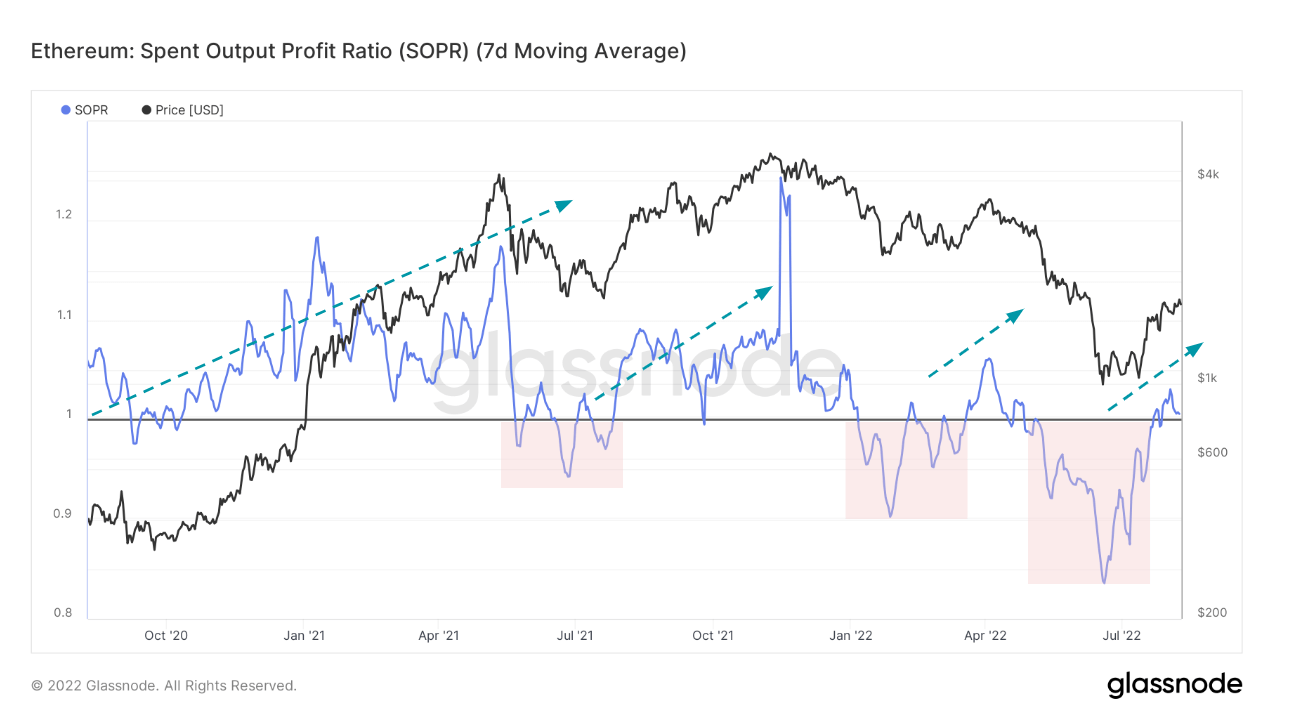The merger causes a divergence between Ethereum and Bitcoin SOPR
The overall market sentiment is usually determined by looking at long-term market behavior. But while zooming out can put current market conditions in a much better perspective, sometimes the most solid measure of the market’s position lies in the middle.
SOPR and its value in market analysis
The Spent Output Profit Ratio (SOPR) is a handy metric for determining overall market sentiment. As the name suggests, the metric compares the value of output when it was used to when it was created. The calculation shows the degree of realized profit for all coins that are moved on the chain in a certain time frame.
When the SOPR exceeds one, the coins in question are trading at a profit. When the ratio is less than one, the coins are trading at a loss. A SOPR ratio of 1 is called a SOPR reset and is often used to signal the start or end of a midcycle. The SOPR reset can also act as support in bull markets or as resistance in bear markets.
While the metric is an elementary and easy to interpret signal, it can be further altered to present a much more complex market picture.
For example, filtering transactions to remove any “in-house” activity (eg transactions between addresses belonging to the same owner) is done through aSOPR, which shows better market signals compared to raw data SOPR. The SOPR and aSOPR calculations can be further segmented into cohorts of long-term and short-term holders.
Bitcoin’s SOPR
For the first time since May, Bitcoin’s 7-day MA SOPR attempted to break above 1. In late July, Bitcoin’s SOPR touched one and has retested it through the first week of August.
Every time Bitcoin hit a SOPR of 1 and failed to break resistance; the price saw a short rise. Attempts to break SOPR resistance have almost always correlated with bear market rallies, sometimes referred to as dead cat bounces.
And while Bitcoin’s failed attempt to break through resistance may look pessimistic, the outlook is positive. Historically, it has always taken several attempts for the SOPR to break above 1. The more it struggled to break through ratio 1, the stronger support it gained later.

Ethereum’s SOPR
Unlike Bitcoin, Ethereum was able to breach the SOPR of 1 on the first try. As of August, Ethereum appears to have found support at 1, with data from Glassnode showing that it quickly recovered from the last drop. Ethereum’s rising SOPR is a direct result of ETH’s rising price, which has defied the broader market trend that keeps most coins deep in the red.
However, while Bitcoin has retested resistance, Ethereum has retested support, showing that the two may be moving in opposite directions. Historically, for the ratio of used manufacturing profits to act as strong support, the ratio had to go through resistance several times for it to act as support.
As previously covered by CryptoSlate, Ethereum’s market-believing rally is largely the result of speculation surrounding the upcoming merger. This is seen in a significant increase in derivatives trading, which pushed the open interest on Ethereum to $6.4 billion – $1.4 billion more than the open interest on Bitcoin. The increase in derivatives trading contrasts with the falling user activity on the network, seen in falling gas charges.
This amount of speculation puts the stability of Ethereum’s SOPR at risk. Any weakness in Ethereum’s price will certainly affect the ratio and push it below 1. If it were to fall suddenly, Ethereum’s SOPR could find strong resistance should it try to break above the level again.



